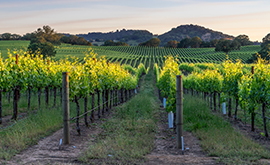Science, Cost and Net Environmental Benefit Explored at NACWA's 2018 Winter Conference
 NACWA’s members gathered in Napa, CA last week to explore the critical balance between science and cost in clean water advocacy, and the possibility of using a net environmental benefit-based approach to addressing the nation’s water challenges.
NACWA’s members gathered in Napa, CA last week to explore the critical balance between science and cost in clean water advocacy, and the possibility of using a net environmental benefit-based approach to addressing the nation’s water challenges.
Committees Work Through Crucial Details of Advocacy Priorities
The Water Quality Committee discussed management strategies that clean water agencies could employ in light of increasingly stringent water quality-based requirements, and the latest developments on the “nutrients front.” The Climate & Resiliency Committee addressed the development of NACWA’s Position Statement on Climate & Resiliency, which will help guide NACWA’s advocacy strategy and positions moving forward. The Utility & Resource Management Committee discussed a range of issues that are currently front-and-center in the infrastructure debate, including governance models and workforce challenges.
The Conference’s second day featured discussions on the latest biosolids developments, a new report on inflow and infiltration (I/I) control strategies for satellite collection systems, and the recently released Oregon Phase II MS4 draft permit, which largely abandons the use of the maximum extent practicable (MEP) standard. The Legal Affairs Committee met to discuss enforcement and consent decree developments, and a re-definition of the appropriate balance between “enforcement” and “compliance assistance/assurance;” and the Communications & Public Affairs Committee discussed the proper messaging of NACWA’s 2018 advocacy priorities and using them for targeted media outreach.
The final afternoon before the start of the Plenary Session featured the Legislative & Regulatory Policy Committee, including an engaging interaction with Andrew Sawyers, Director for EPA’s Office of Wastewater Management, who discussed the latest developments and issues involved in utility governance, infrastructure funding, tax reform and the Congressionally required National Academy of Public Administration report on affordability.
All committees received updates on current NACWA advocacy priorities, and through these discussions, provided additional direction for NACWA advocacy efforts and engagement in the new political landscape in Washington, DC.
Meetings and Plenary Sessions Offer Perspective, Provide Possible Points of Action
The Conference’s first Plenary Session was kicked off with remarks by NACWA’s President, David St. Pierre, the Executive Director of the Metropolitan Water Reclamation District of Greater Chicago. And after remarks by the Mayor of Napa, CA, Jill Techel, attendees listened to a keynote address by Diane Katz, Senior Research Fellow, Regulatory Policy of the Heritage Foundation, in which Ms. Katz discussed various perspectives on regulatory trends relevant to the Trump Administration’s decision-making.
A definite highlight of the conference was a roundtable with members from Puerto Rico, Texas and California, and their efforts on resiliency in the face of natural disasters. Other roundtable discussions tackled the “relentless incrementalism” of complex regulatory standards; whether or not to make significant financial investments to meet water quality requirements, if those investments do not translate into environmental improvement; and whether or not clean water agencies should have the flexibility to make smarter investments that are more protective of public health and the environment, while maximizing the return on their ratepayers’ investment.
Day one of the plenary was rounded out with a discussion that looked holistically at “big data,” advanced technology and watershed-based improvement. The last plenary session featured two panels, one exploring whether science should drive policy and when policy may dictate decisions not fully supported by the science, and the second, a look at outcome-based engineering, and how utilities are reinventing the way they treat wastewater to meet the goals of tomorrow.
Board Engages on Key Advocacy Issues, Approves Two TAF Projects
The NACWA Board met during the first day in Napa, and discussed a number of NACWA’s top advocacy priorities, in addition to hearing from several key speakers from partner organizations. The Board provided staff with direction regarding engagement on the issue of governance and EPA’s survey on nutrients, among other areas.
The Board also reviewed NACWA’s revised Strategic Plan – based on input from the Fall Strategic Leadership Meeting – and the proposed FY 2018 Business Plan, and approved funding for two Targeted Action Fund (TAF) projects that will ensure the Association and its members will be well-positioned on key policy issues that are already being discussed in Washington, DC. With the next iteration of the Farm Bill now under development, NACWA is working to ensure that enhancements are made to key conservation funding programs, including the Regional Conservation Partnership Program (RCPP), to make them more efficient. The first TAF project – $36,000 in FY 2018 TAF support approved by the Board – will allow the Association to continue engaging with key experts who have been working to advance NACWA’s advocacy goals related to agriculture and the Farm Bill
The second approved TAF effort – $7,500 from the FY 2018 TAF – will help support an examination of the pros and cons of public-private partnerships for water and wastewater utilities led by The Water Research Foundation. The research will analyze the opportunities and impediments to implementing public-private partnerships, and will include an analysis of case studies from public-private partnerships covering the full spectrum of partnership structures. Unlike previous work on the subject, this research will be led by the public water sector for use by public utilities and will help to inform the current infrastructure dialogue and provide NACWA members with valuable insights as they consider these partnerships models.